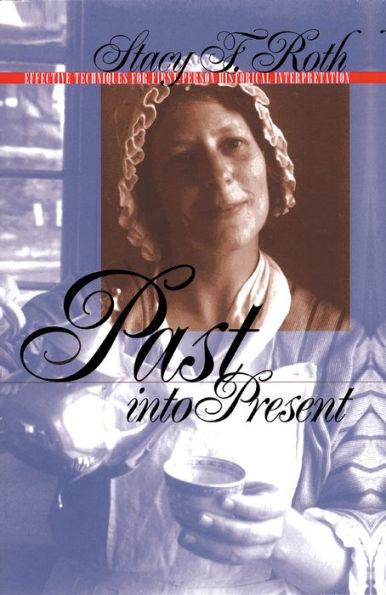Past into Present: Effective Techniques for First-Person Historical Interpretation
First-person interpretation--the portrayal of historical
characters through interactive dramatization or roleplaying--is
an effective, albeit controversial, method used to bring history
to life at museums, historic sites, and other public venues.
Stacy Roth examines the techniques of first-person interpretation
to identify those that have been most effective with audiences
while allowing interpreters to maintain historical fidelity.
Past into Present focuses on first-person
interpretation's most challenging form: the unscripted,
spontaneous, conversational approach employed in "living history"
environments such as Plimoth Plantation in Massachusetts, Conner
Prairie in Indiana, and Colonial Williamsburg in Virginia. While
acknowledging that a wide range of methods can touch audiences
effectively, Roth identifies a core set of practices that combine
positive communication techniques, classic interpretive
philosophy, and time-tested learning theories to promote audience
enjoyment, provoke thought and inquiry, convey important messages
and themes, and relate to individual visitor interests. She
offers numerous examples of conversation and demonstration
strategies, visitor behavior profiles, and suggestions for
depicting conflict and controversy, and she provides useful
character development guidelines, interpretive training advice, and recommendations for adapting first-person interpretation for
diverse audiences.
1111445180
characters through interactive dramatization or roleplaying--is
an effective, albeit controversial, method used to bring history
to life at museums, historic sites, and other public venues.
Stacy Roth examines the techniques of first-person interpretation
to identify those that have been most effective with audiences
while allowing interpreters to maintain historical fidelity.
Past into Present focuses on first-person
interpretation's most challenging form: the unscripted,
spontaneous, conversational approach employed in "living history"
environments such as Plimoth Plantation in Massachusetts, Conner
Prairie in Indiana, and Colonial Williamsburg in Virginia. While
acknowledging that a wide range of methods can touch audiences
effectively, Roth identifies a core set of practices that combine
positive communication techniques, classic interpretive
philosophy, and time-tested learning theories to promote audience
enjoyment, provoke thought and inquiry, convey important messages
and themes, and relate to individual visitor interests. She
offers numerous examples of conversation and demonstration
strategies, visitor behavior profiles, and suggestions for
depicting conflict and controversy, and she provides useful
character development guidelines, interpretive training advice, and recommendations for adapting first-person interpretation for
diverse audiences.
Past into Present: Effective Techniques for First-Person Historical Interpretation
First-person interpretation--the portrayal of historical
characters through interactive dramatization or roleplaying--is
an effective, albeit controversial, method used to bring history
to life at museums, historic sites, and other public venues.
Stacy Roth examines the techniques of first-person interpretation
to identify those that have been most effective with audiences
while allowing interpreters to maintain historical fidelity.
Past into Present focuses on first-person
interpretation's most challenging form: the unscripted,
spontaneous, conversational approach employed in "living history"
environments such as Plimoth Plantation in Massachusetts, Conner
Prairie in Indiana, and Colonial Williamsburg in Virginia. While
acknowledging that a wide range of methods can touch audiences
effectively, Roth identifies a core set of practices that combine
positive communication techniques, classic interpretive
philosophy, and time-tested learning theories to promote audience
enjoyment, provoke thought and inquiry, convey important messages
and themes, and relate to individual visitor interests. She
offers numerous examples of conversation and demonstration
strategies, visitor behavior profiles, and suggestions for
depicting conflict and controversy, and she provides useful
character development guidelines, interpretive training advice, and recommendations for adapting first-person interpretation for
diverse audiences.
characters through interactive dramatization or roleplaying--is
an effective, albeit controversial, method used to bring history
to life at museums, historic sites, and other public venues.
Stacy Roth examines the techniques of first-person interpretation
to identify those that have been most effective with audiences
while allowing interpreters to maintain historical fidelity.
Past into Present focuses on first-person
interpretation's most challenging form: the unscripted,
spontaneous, conversational approach employed in "living history"
environments such as Plimoth Plantation in Massachusetts, Conner
Prairie in Indiana, and Colonial Williamsburg in Virginia. While
acknowledging that a wide range of methods can touch audiences
effectively, Roth identifies a core set of practices that combine
positive communication techniques, classic interpretive
philosophy, and time-tested learning theories to promote audience
enjoyment, provoke thought and inquiry, convey important messages
and themes, and relate to individual visitor interests. She
offers numerous examples of conversation and demonstration
strategies, visitor behavior profiles, and suggestions for
depicting conflict and controversy, and she provides useful
character development guidelines, interpretive training advice, and recommendations for adapting first-person interpretation for
diverse audiences.
29.99
In Stock
5
1

Past into Present: Effective Techniques for First-Person Historical Interpretation
272
Past into Present: Effective Techniques for First-Person Historical Interpretation
272
29.99
In Stock

Product Details
| ISBN-13: | 9780807864241 |
|---|---|
| Publisher: | The University of North Carolina Press |
| Publication date: | 11/09/2000 |
| Sold by: | Barnes & Noble |
| Format: | eBook |
| Pages: | 272 |
| Lexile: | 1440L (what's this?) |
| File size: | 6 MB |
About the Author
What People are Saying About This
From the B&N Reads Blog
